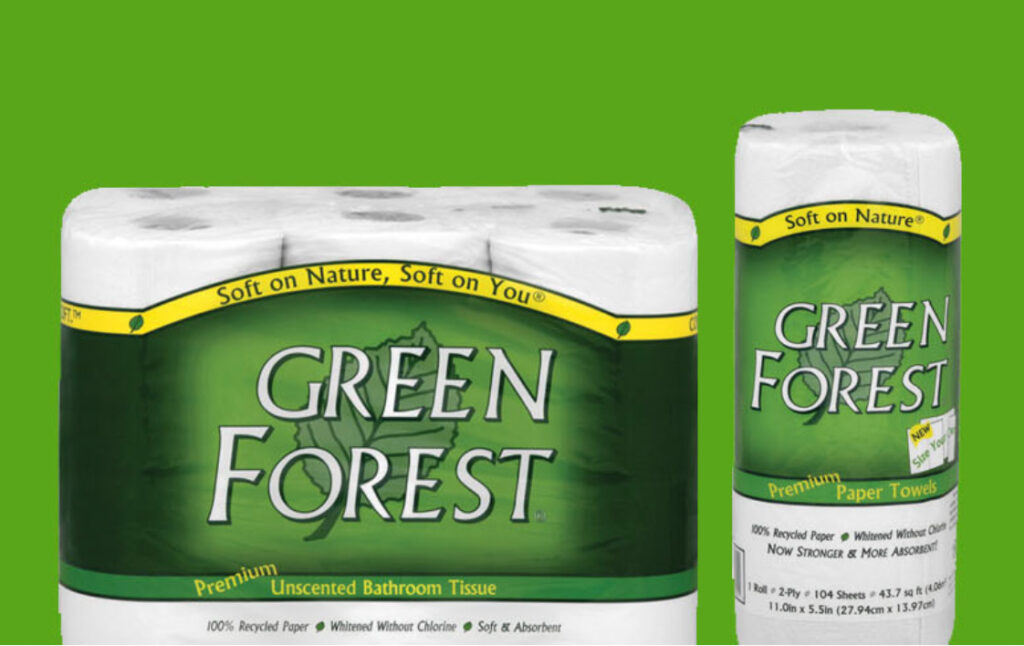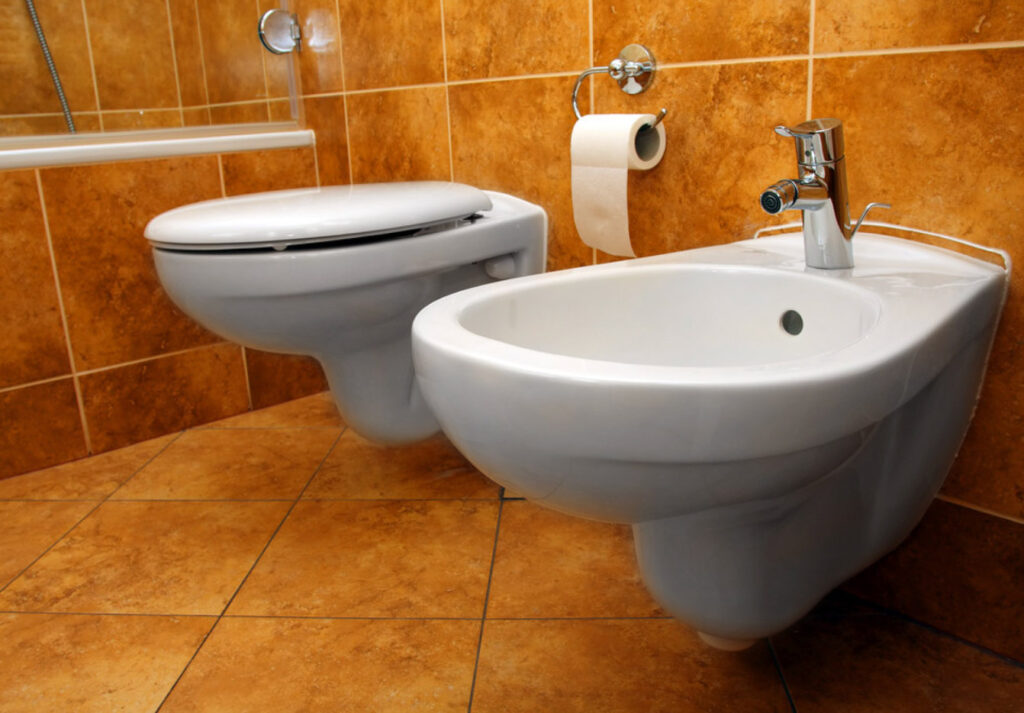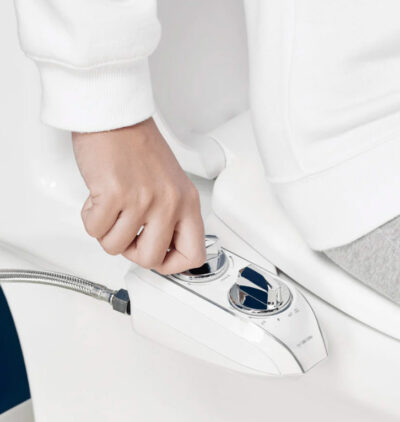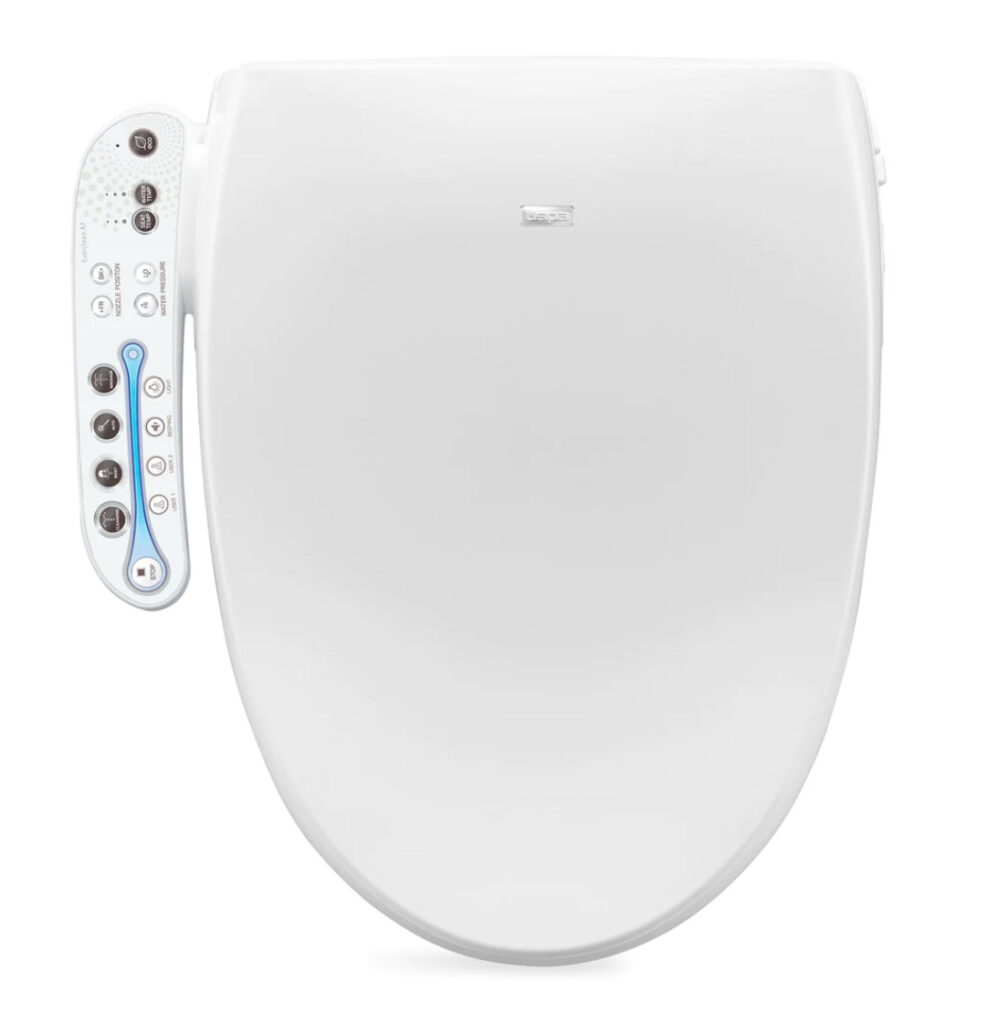Planet-Friendly Potty Time: Eco-Friendly Toilet Paper vs. Bidets
Estimated reading time: 19 minutes
Having traveled to over eighty countries, I can tell you that I have seen (and used) my fair share of different kinds of toilet paper and bidets. I’ll admit that bidets took some getting used to, and you definitely want to become accustomed to adjusting the settings before trying one. However, I found that the experience was overall sustainably positive!
Although they showed up centuries ago in France and are popular in many countries worldwide, North Americans haven’t hopped on the bidet wagon. Could we make a more environmental choice in our health routine if we switched from eco-friendly toilet paper to a bidet? Let’s find out!

This article contains affiliate links. Learn more about this here.
Key Takeaways
- Americans account for more than 20% of global tissue consumption, using approximately 15 million trees and 3.7 billion gallons of water per year to produce.
- One of the many chemicals in toilet paper is PFAS, nicknamed “forever chemicals” because they do not degrade in the environment.
- Eco-friendly toilet paper like those made from recycled products and bamboo have a much smaller environmental footprint.
- There are many different kinds of bidets to choose from, and they all have environmental and health benefits.
- The average bidet uses 1/8 of a gallon of water to clean and flush, making it more eco-friendly than any kind of toilet paper.
Jump Ahead:
Why should we use eco-friendly toilet paper?
The best green toilet paper options
What’s the deal with bidets anyway?
The best eco-friendly bidet options for sustainable bathroom practices
The ultimate debate: bidet vs. toilet paper
Why Should We Use Eco-Friendly Toilet Paper?
We should first probably discuss why it matters which toilet paper you choose. Second only to China, the U.S. tissue market generates $31 billion each year, with Americans accounting for more than 20% of global tissue consumption (while only making up about 4% of the world’s population.) This is A LOT of tissue.
The Environmental impacts of toilet paper
First, toilet paper is made from wood pulp, which is clearly from trees. Approximately 15 million trees are pulped per year to provide the 36.5 billion rolls of toilet paper used by Americans annually. Much of this comes from the boreal forest of Canada, where deforestation is causing issues such as increased carbon emissions, habitat and biodiversity loss, and impacts on Indigenous communities.
Second, according to this article published in The Scientific American, toilet paper manufacturing requires about 17.3 terawatts of electricity annually, not accounting for the energy used to produce the plastic packaging or transportation of the product.
Another oft-overlooked issue with tissue is the quantity of water used to create it. Each day, 3.7 billion gallons of water are used to produce the amount of toilet paper U.S. consumers use. This is roughly 12 gallons per person per day!

Chemicals in toilet paper
Let’s not forget what else is in toilet paper besides wood pulp hailing from all those trees. This can include bleach, chlorine, formaldehyde, and fragrances – all of which can cause irritation to more severe health problems. Not to mention what it does to our waterways and aquatic organisms when flushed down the toilet.
One of the most concerning chemicals in toilet paper is PFAS (per- and poly-fluoroalkyl substances), which are found in various products from cosmetics to cleaning products. Nicknamed “forever chemicals” because they do not degrade in the environment, they have been linked to health issues from liver damage to infertility and certain types of cancer. Multiple surveys over two decades have found that most people in the U.S. have amounts of PFAS in their bloodstream.
Once released into the water system, they can wreak havoc on ecosystems too. From this Medical News Today article – “For a specific type of PFAS — called “disubstituted poly-fluoroalkyl phosphates” (diPAPs) — researchers found toilet paper contributes about 4% of it to sewage in the United States and Canada, 35% in Sweden, and up to 89% in France.”

Want to avoid these forever chemicals? Don’t buy anything with perfluor-, polyfluor-, and PTFE on the label. You can find a list of PFAS-free products here.
Bamboo vs. Recycled Toilet paper
When it comes to finding eco-friendly toilet paper, there are two main options – those made from recycled materials, and those made of bamboo fibre. Both have their advantages and disadvantages.
Recycled toilet paper is made with paper scraps. Although this cuts down on deforestation, energy, and water use, some of these glossy paper scraps have a thermal coating that contains BPA. However, the recycled content in toilet paper can be marked as 100% recycled even if less than half the content came from recycled materials!
According to the NRDC, bamboo has a smaller footprint than virgin forest fiber, but larger than recycled paper and some plant-based toilet paper such as wheat straw. The sustainability of bamboo toilet paper can also depend on whether it was sourced in a way that considers human rights and environmental impacts.
So, although knowing which of these two alternative toilet papers is more sustainable may not be 100% clear, we can safely say that they are both better options than virgin wood-pulp fibers.
The Best eco-friendly Toilet Papers
So, if I’ve convinced you to stop using chemical-laden, deforestation-encouraging toilet paper, it’s only fair I provide you with some alternatives. Sustainable toilet paper is one of the best eco-friendly bathroom product swaps you can make to green your home. Let’s explore some eco-friendly toilet paper options from sustainable toilet paper brands.
Plant Paper Toilet Paper
This 3-ply silky soft paper is Made from FSC Certified, organically grown bamboo pulp harvested in China. Plant Paper is chlorine (bleach) and PFAS-free and delivered in 100% plastic-free packaging. It is also septic-tank safe and you can get a subscription to receive your paper with free shipping in the U.S. at intervals of your choosing for convenience!


Cloud Paper
Cloud Paper is made from 100% responsibly sourced, FSC-certified bamboo. Lightened with an elementally chlorine-free bleaching process, it contains no PFAs, added scents, or pesticides. Choose from a one-time purchase or customizable subscription options and have this plastic-free toilet paper delivered in a post-consumer recycled box. You can cancel your subscription penalty-free anytime, but you won’t want to!
Reel Bamboo Toilet Paper
This tree-free toilet paper alternative is made from , 100% bamboo paper without inks, dyes, or BPAs. Reel is an FSC-certified B Corporation. Products are shipped with zero plastic packaging, even the tape. Reel also sells other paper products made with at least 80% post-consumer fiber sourced exclusively from North America and made in the U.S.


Green Forest Bathroom Tissue
This soft yet strong toilet paper is made from 100% recycled paper fiber, with a minimum of 90% post-consumer recycled content. It is septic-safe and biodegradable toilet tissue with an environmentally safe oxygen-based bleaching process that ensures it is chlorine-free. Available in 2-ply in both single and double roll sizes. Find all vendors here.
What’s the Deal with Bidets anyway?
If you want to eliminate or use drastically less toilet paper, why not try a bidet?
Bidet History & Types
The invention of the bidet was placed in France in the late 17th century, although no exact date or inventor is known. It wasn’t until after the Second World War that they became quite popular in many European countries, South East Asia, South America, and the Middle East. They haven’t become widely used in North America, although many have recently noticed an upswing in the trend.
There are now many types of bidets – freestanding or stand-alone bidets, bidet toilet seats, handheld bidet sprayers, built-in bidets or bidet toilet combos, bidet attachments, and portable bidets. Your choice will be determined by space availability, comfort, and budget.
If you own your home and have the space, you could take your potty time pick of the whole lot. Rent the apartment or space you live in? You may opt for a bidet toilet seat, attachment, or portable bidet. Regardless of your living quarters, there is an option for you!

Need some help learning how to use a bidet? Check out this great article.
The Benefits and Barriers of Bidets
Aside from environmental ones, there are many benefits to using a bidet (more on that later!) Bidets are more gentle on your skin than toilet paper, which can cause cuts, scrapes, and abrasions. If you suffer from hemorrhoids or fissures, this might be reason enough alone to make the switch. If you opt for a toilet seat bidet or bidet attachment, they are super easy to set up. Bidets can also be more user-friendly for those with mobility issues, especially older people. Even though a bidet will cost more initially, the savings over time from less (or no) toilet paper use will outweigh the cost. And you’ll clog the toilet less with all that paper!
Bidets are often regarded as more hygienic than toilet paper, cleansing your derriere more effectively of fecal matter. Never again will you need to deal with toilet paper crumbs; you’ll always have that fresh-out-of-the-shower feeling down there. Let’s not forget that you’ll also never have to worry about another toilet paper craze leaving you without any way to wipe!
There are some barriers to bidets, too. Some may be unable to afford the up-front cost – although, with so many options on the market, this barrier may be eliminated soon. Some may not be able to complete the bidet attachment installation independently due to mobility issues or other reasons. The bowl size of your toilet may be limiting to the type of bidet you could purchase. And, as with anything, the lack of availability or water access is a limiting factor to eco-conscious toilet hygiene.
The Best Bidets
I’ve scoured the internet for the top-reviewed, best-selling bidet attachments, seats, travel bidets, and sprayers to bring you a list that will surely fit your style and budget.
Best bidet attachments
Tushy Classic 3.0
Choose from a light to strong stream of clean water with this best-selling bidet from Tushy. Now with a patented Self Cleaning SmartSpray™ nozzle that rinses before and after each use for a better clean. Compatible with most standard toilets in a luxury design and antimicrobial bamboo or brass knob to suit any bathroom. You can install yourself in just 8 ½ minutes and access on-demand support from their expert Poo-Rus for any unforeseen troubles. With over 100,000 five-star reviews and a one-year warranty, it’s a safe choice for your bidet needs!


Whisper Bidet Self-Cleaning Attachment
The Whisper Bidet attaches easily to 90% of toilets in about ten minutes without special tools. Water is drawn from the clean water supply behind the toilet to leave you feeling after-show clean. This non-electric bidet attachment is 100% hydro-powered. Twist the knob to your desired setting, rinse clean, dab dry, and voila! With a 60-day money-back risk-free trial to U.S. customers, you literally can’t go wrong. Plus, you’ll get free shipping within the contiguous 48 states and a one-year warranty.
Luxe Bidet NEO 185 Plus
With its Patented LUXE-Hinge Adjustment Plates, the slide-in installation makes this attachment super simple to add to your toilet or swap between bathrooms. You can adjust your spray to fit your needs with dual wash nozzles, water pressure, and mode selection. With an advanced 360° self-clean mode and EZ-Lift design, you won’t need to worry about any mess either. Choose from chrome, white, or rose gold colors to match your style needs!

Top Travel and Portable Bidets
brondell gospa Travel Bidet
If you’re looking for an eco-friendly, affordable, and transportable bidet for travel or backcountry hiking, this is it! Its collapsible design makes it compact, and the stow-away storage bag keeps it clean and discreet. The 100% silicone body is BPA-free, with a screw-top lid for easy filling. Just aim the angled spray nozzle and use the easy-squeeze technology for a powerful spray on the trail, in your hotel room, or anywhere you need it! Comes with a one-year warranty and a choice of twilight blue, blush, or black. No more need to pack out your dirty toilet paper while exploring outdoors!


Toto Travel Washlet
Do you prefer something a little more luxe and battery-powered? The Toto Travel Washlet has a convenient push-button design and two different washing modes, allowing you to adjust for your needs. Choose between regular (three streams of water) and soft (five streams of water) for maximum comfort. It is super easy to use -just fill the water reservoir and extend the wand. The compact Travel Washlet comes with a carry case and batteries to take you from home to the airport, camping and beyond.
Sublime Seats
Bio Bidet USPA A7 Bidet Seat
This seat has so many features, it’s incredible! A heated seat, hybrid warm water, warm air dryer, night light, and massage wash are like a spa for your backside. The side control panels and user presets easily achieve adjustable water pressure. The hideaway installation is simple to do yourself. This is an electric bidet seat that requires a nearby GFCI outlet. Free Shipping Over $199 (U.S. only)


Brondell EcoSeat S101
Powered by water pressure, not electricity, the EcoSeat S101 is designed for easy installation. With hygienic dual retractable angled nozzles and adjustable water pressure, you’ll feel clean and fresh after doing your bathroom business. The self-cleaning nozzles retract to stay clean between uses, and high-quality components ensure long-lasting performance. The EcoSeat is available as an elongated or round bidet toilet seat.
Superb Bidet Sprayer
The PurrfectZone stainless steel Bidet/Cloth Diaper Sprayer
This attachment can be used as a bidet to clean intimate areas, clean cloth diapers, or the toilet itself. Adjust the pressure to ensure a refreshing clean within your comfort zone. You won’t need any tools to install this multi-purpose sprayer. Made with robust stainless steel hardware that will last years, it will help save you money over time while positively impacting the environment. Backed by the Purrfectzone Promise – a commitment to your satisfaction.

The Ultimate Debate: Bidet vs. Toilet Paper
I think it’s clear that using a bidet is better than using toilet paper made from virgin wood pulp, but just in case you’re not convinced, let’s do the math.
Manufacturing a single roll of toilet paper also uses 37 gallons of water. The average American uses 141 rolls per year, making their water use just for the manufacturing 5,217 gallons (20, 868 liters)! The average bidet uses 1/8 of a gallon of water to clean and flush. Even if it is used a generous eight times a day, this equals only 365 gallons per year. I couldn’t determine how much one-time water is used to create your average bidet attachment. However, suppose we use the water footprint of 28 gallons of water per pound of plastic. In that case, we can safely say that perhaps it is approximately 100 gallons or less (allowing for two pounds and other features). Making your yearly water total with a bidet 465 gallons compared to 5,217 (keeping in mind the bidet will last you far longer than a year!)
Another way bidets prove themselves to be environmentally superior is the lack of chemicals they introduce into our waterways compared to (traditional) toilet paper. Not to mention the throwaway plastic packaging toilet paper comes in versus the one-time creation of your bidet (which may be made from plastic if we’re being honest.)

But what about eco-friendly toilet paper?
We can now all agree that using environmentally friendly toilet paper like the ones mentioned in this article is more sustainable than typical T.P. But is it better than a bidet?
Let’s consider that even though eco-friendly toilet paper made from recycled or bamboo fibers requires less water than virgin wood pulp, you’ll still be using that average of 141 rolls a year. Compare this again to your one-time water use for bidet manufacturing, and the bidet comes out the winner in this respect.
If you’re not ready to give up the sheets entirely, try using a square or two of eco-friendly toilet paper to pat dry after using your bidet for the ultimate sustainable combo! Or, you could try some reusable, washable towels rather than T.P. for this job. Try these ones made with organic cotton from Zero Waste Store.

Reusable Paper Towels – zero waste store
About this item:
- Plastic free
- 100% organic cotton
- OEKO-TEX standard
- 1% for the planet
- Carbon neutral
For sustainability on a budget, take some advice from fellow Earth enthusiast Jenn Wilson, who bought her bidet just before the pandemic – “I turn an older towel into bidet cloths and trim them with scissors to keep the fray down. I use a foot pedal bin with a lid beside the toilet for the used cloths to keep pet noses out.”
Toilet paper and Bidet Alternatives
If you’re hoping to stop using toilet paper entirely, you have options! Check out these bidet accessories for sustainability.
Try reusable cloths – much like cloth diapers, you toss them in the wash after use. Keep a basket full where you do your business and a “disposal” container for the used ones. The ones above from Zero Waste Store or these ones from Cheeks Ahoy would suffice.

Reusable Cloth Wipes – Cheek Ahoy
About this item:
- 100% cotton
- Set of ten
- Single-ply
- Handmade in Canada
Want to use a bidet but not sure you want to drop the funds for it right now? Try a DIY bidet using a squeeze bottle, as described in this article.
Another option is to choose used paper around the house like newspapers or old school notes you no longer need. Make sure to soften it with a bit of water first, and make sure to throw it in the trash rather than flushing it!
Feeling super ambitious? Mullein leaves have been used to wipe behinds for thousands of years, are soft, large, and have no toxic properties. Learn more about these and four other plants you can grow to use as toilet paper in this article.
Making the largest impact
Want to make an even more significant positive impact on your potty time?
- Reduce your water consumption in the bathroom by installing low-flow toilets and practicing “if it’s yellow, let it mellow; if it’s brown, flush it down.”
- Support change for the way poop is managed. Learn more about this at the EPA’s website.
- Invest in a composting toilet. Don’t forget to use a bidet or compostable toilet paper!
- Need other bathroom products? Support sustainable brands that create eco-friendly items for all your washroom needs.
Final thoughts on planet-friendly potty time
Feeling overwhelmed? Start small! Next time you’re in need, make a responsible toilet paper choice and purchase some eco-friendly toilet paper. Your next step might be to try out a DIY or travel bidet and see what you think. Once you’re used to that, invest in a bidet seat or attachment for your home and check out some reusable cloths to replace that environmentally-friendly toilet paper. Before you know it, you’ll be pooping with maximum sustainability!
All products recommended to you on Successfully Sustainable are independently researched in depth. To avoid waste and lead a minimal lifestyle, we test products only when required. This post contains affiliate links. If you buy something through our links, we may earn a small commission. Learn more about this here.





